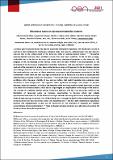Por favor, use este identificador para citar o enlazar a este item:
http://hdl.handle.net/10261/260791COMPARTIR / EXPORTAR:
 SHARE
BASE SHARE
BASE
|
|
| Visualizar otros formatos: MARC | Dublin Core | RDF | ORE | MODS | METS | DIDL | DATACITE | |

| Título: | Biosensors based on optonanomechanical systems |
Autor: | Calleja, Montserrat CSIC ORCID | Fecha de publicación: | 20-sep-2021 | Citación: | Congreso Español de Nanofotónica (2021) | Resumen: | A primary goal of optomechanics has been to exploit the interaction of photons with mechanical systems to cool down their fundamental mechanical vibration mode, but recently, optomechanics has also played a relevant role in the enhancement of the detection limits of nanomechanical sensors. [1,2] Resonating nanomechanical structures have provided extreme force and mass sensitivity, in the zN and yg range, achievable due to the devices low mass and extraordinary mechanical properties at the nanoscale. Still, progress in the downscaling of the devices would have not been fruitful if not accompanied by the development of non-invasive displacement detection techniques with sub-picometer sensitivity. Optical read-out of the resonators by a laser beam probe has been a successful approach in the last decades, despite the challenges faced for mechanical systems with dimensions below the optical wavelength. We have found that semiconductor structures, as silicon nanowires, can support optical resonances associated to the light confinement within them and that such light confinement can be harnessed to achieve an unprecedented optomechanical coupling in these tiny structures. [3,4] The result is that we can obtain regenerative mechanical oscillation with a frequency stability of one part per million, that readily translates into zeptogram mass resolution at room temperature. This approach offers significant advantages with respect to previous frequency detection methods, as it allows the detection of the Brownian motion of small nanowires, so there is no need of external excitation, which allows a high degree of simplification in the design of the sensors. The concept of exploiting internal optical resonances together with the ever-increasing control in the fabrication of nanowires opens up immense opportunities to develop robust and reliable optonanomechanical devices for the detection of single biomolecular recognition events in liquids and single molecule spectroscopy in vacuum. We will also discuss how strategies inspired by these phenomena applied to microscale devices have served for cancer cell characterization, [5] and how light confinement in plasmonic particles and optoplasmonic cavities can be harnessed for the detection of attogram per mililliter concentrations of protein biomarkers. [6] These technology advancements are now allowing us to explore the formerly elusive deep plasma proteome. [7] | Descripción: | Resumen del trabajo presentado en el Congreso Español de Nanofotónica CEN2021, celebrado online, del 20 al 22 de septiembre de 2021 | URI: | http://hdl.handle.net/10261/260791 |
| Aparece en las colecciones: | (IMN-CNM) Comunicaciones congresos |
Ficheros en este ítem:
| Fichero | Descripción | Tamaño | Formato | |
|---|---|---|---|---|
| Biosensors based on optonanomechanical systems.pdf | 155,82 kB | Adobe PDF |  Visualizar/Abrir |
CORE Recommender
NOTA: Los ítems de Digital.CSIC están protegidos por copyright, con todos los derechos reservados, a menos que se indique lo contrario.
